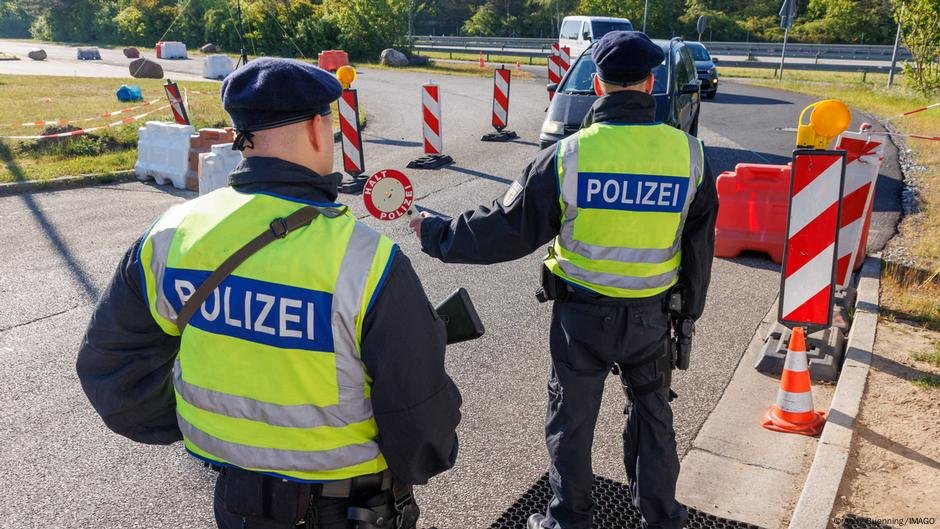The European landscape changed forever when in the late summer months of 2015 thousands upon thousands of people started to reach the EU in search of a better and — above all — safer life. We take a comprehensive look back at the major events that have since had a major impact on the European migration debate over the past decade, assessing how the past will continue to inform the future. This is the final part in a series of five articles, focusing on 2023-2025.
"Wir schaffen das."
Translation: "We can cope."
The consequences of these three words might in future be regarded as having had the biggest lasting impact on Europe since the end of World War II — perhaps only second to the fall of the Berlin Wall and the subsequent end of the Cold War.
Former German Chancellor Angela Merkel uttered this short sentence during a press conference on August 31, 2015, telling the world that Germany and Europe at large would confidently manage the growing number of refugees and migrants reaching the continent from all over the world, in particular from war-torn Syria.
Many things have changed in the ten years since. New refugee and migration movements happened, and the continent has witnessed seismic shifts in policies and politics, as well as in attitudes toward migration.
InfoMigrants looks at some of at the biggest events of the past decade, exploring whether — and how — Europe did manage to cope in the end.
This article looks specifically at the years 2023, 2024 and 2025 as part of series.
2023: Conflicts and major shipwrecks
Conflicts heat up around the world
Migration observers paid close attention to major events and humanitarian emergencies in 2023, as conflicts in Sudan and the Democratic Republic of Congo (DRC) displaced millions of people. The conflict in Sudan has displaced 12 million people, and around 4 million have fled the country. However, most have fled to neighboring countries -- mainly to Chad, South Sudan, Egypt, Ethiopia, and the Central African Republic.
In the Middle East, the deadly October 7 attacks in Israel were followed by a major offensive by the Israeli Defence Force into the Gaza Strip to dismantle Hamas. Since Egypt closed its border to Gaza, the enclave has effectively been shut off from the rest of the world ever since, making any attempts to escape the territory and claim asylum nearly impossible. The events in the Middle East in particular are believed to have had an impact in changes attitudes towards both Muslims and Jews across Europe.
Meanwhile, the war in Ukraine entered its second year, with countries near Russia reassessing their border policies; Finland, for example, repeatedly closed and fortified its border crossings with Russia, as a growing number of migrants started to present for asylum there in a similar manner as had been the case with Belarus and Poland and the Baltic states the year before. The Nordic country also introduced a set of new laws making it more difficult to qualify for asylum.
Syrian refugees displaced by earthquakes in Turkey and Syria
A series of massive earthquakes in southeast Turkey killed nearly 60,000 people, about 6,000 of whom were Syrian war refugees. Many Syrians who had settled in Turkey and had rebuilt their lives there had to start all over again, with some deciding to take this moment as an opportunity to return to their home country; in total, over 40,000 Syrians are believed to have returned in response, with some reporting that they were motivated by a sense of growing Xenophobic sentiments in Turkey after the tragedy.

Major shipwrecks in the Mediterranean Sea
2023 also saw migrant tragedies of major proportions, with two shipwrecks in different parts of the Mediterranean Sea making global headlines.
On June 14, approximately 600 migrants died in a massive shipwreck off the coast of Pylos, Greece. The victims, hailing from Pakistan, Syria, Egypt and Afghanistan, among other nations, were aboard an overcrowded fishing trawler, the Adriana, which was carrying up to 700 people. Only 104 survived, and 82 bodies were recovered. The boat reportedly capsized during an attempt by the Greek Coast Guard patrol boat to tow the vessel into safety.
Investigations by various media outlets and human rights organizations later revealed that the Greek coast guard had delayed the rescue operations, as passengers on board the boat had rejected assistance in fear of being sent back or pushed back. Court cases ensued in which negligence on the part of coast guard officials was at least partly identified as one of the reasons for the tragic incident at sea. A report published by the EU border agency Frontex later suggested that at least some of the deaths could have been prevented.

Earlier in the year, close to 100 migrants had died in an incident off Italy's coast of Calabria near the town of Cutro when their boat ran aground and broke up in shallow waters after sailing for four days from Turkey. The small vessel is thought to have been carrying some 180 people, mainly from Syria and Afghanistan as well as Iran. Legal probes into the event were largely inconclusive, though charges of negligence were tabled against coast guard officials. The tragedy prompted the Italian government to issue a series of laws and decrees further restricting irregular immigration.
Italy: New immigration legislation
First, the so-called Cutro decree was issued in response to the tragedy in Italy, which included tougher penalties against smugglers, restrictions on special protection permits, limits on protection categories, as well as tougher immigration control measures (longer detention periods). The government claimed that the decree is yet another step in ensuring that the business model of smugglers is disrupted, making Italy as a destination less attractive.
Not long thereafter, the Piantedosi Decree was issued, named after Italy's Interior Minister, which imposed strict limitations on private sea-rescue operations run by NGOs in the Mediterranean, specifying that organizations like Doctors Without Border (MSF), Sea-Watch, Sea-Eye and others are only allowed to pick up one group of migrants stranded at sea at a time, and immediately start taking them to an assigned safe port thereafter. The NOGs say this has severely hindered rescue efforts at sea, as it means that such private vessels cannot perform several rescue missions in one go anymore (until they run out of capacity on deck). Furthermore, under the decree, the ports assigned to private NGO missions have tended to be hundreds and in some cases even over 1,000 kilometers away from the place of rescue, meaning that these rescue missions end up losing a lot of time while slowly traveling to an assigned port far away instead of continuing their work with saving lives at sea.
Read AlsoFrom Lampedusa to Mayotte, a year of reporting alongside migrants
2024: New laws across Europe
Italy-Albania deal to outsource asylum procedures
Italy signed a deal with non-EU member Albania in a bid to have at least some migrants intercepted at sea by Italian officials transferred to centers there to have their asylum claims processed. According to the plan, successful cases would be transferred to Italy and failed asylum seekers would be deported directly from Albania.
Two centers were constructed in Albania for asylum seekers to be processed and detained prior to their deportation or to be sent on to Italy. The cost of the scheme has been reported to be 670 million euros over five years -- all financed by the Italian government.
But the agreement never took off in practice: Despite manning and staffing the facilities and intercepting migrants at sea, the facilities remain practically unused, as judges in Italy have repeatedly blocked the transfer and processing of migrants there. Those who briefly arrived in Albania were immediately sent back to Italy, creating an ongoing disagreement between the executive and judiciary branches of the Italian government. The future of the Albania deal remains unclear -- to date, they are being used as CPRs, repatriation centers where migrants who are detained in Italy ahead of their expulsion can be transferred.

Germany: Obtaining citizenship becomes easier
Meanwhile, there were also some major legal developments in Germany in regards to immigration issues. One long-awaited change was the introduction of dual citizenship in Germany, which prior to 2024 had been practically impossible to obtain in most instances. With this new law, thousands of people, whose families had migrated to Germany one, two or even three generations ago could finally obtain full German citizenship, and in the same breath, obtaining citizenship also became easier for new arrivals, as long as they were highly qualified professionals with advanced German-language skills. These changes are meant to make Germany attractive as a destination for immigrants with skills and expertise in sought-after careers.
At the same time, Germany also started to crack down on people without a right to be in the country, expanding the deportation laws under the Repatriation Improvement Act (Rückführungsverbesserungsgesetz). In short, this law is designed to speed up repatriations and deportations of people who are proven to have no right to remain in Germany -- in particular those who have been convicted of a criminal offense or have been proven to be a member of a criminal organization. The law also extends the amount of time that people can be detained pending their deportation and allows police to search migrant homes without a legal warrant, as long as a deportation order is outstanding against a person.
EU Asylum and Migration Pact
Meanwhile, after years of negotiations, the EU Parliament approved its long-awaited asylum reform package. The New Asylum and Migration Pact provides for a significant tightening of asylum regulations across the bloc, including speeding up asylum procedures and strengthening border management. The new laws also aim to share out responsibility for migration and asylum more fairly across the bloc. Member States now have until 2026 to transpose the new rules into national law, when the reforms are set to take effect.
Syria: The fall of Assad and the question of return
News of Syria's liberation towards the end of 2024 came as a surprise to the entire international community. The Assad dynasty came to an unexpected end when the Hayat Tahrir al-Sham (HTS) marched into the capital Damascus, encountering only little resistance on its way. The group, formerly viewed as an Islamist organization, soon pledged to rebuild Syria as a pluralistic nation. The news of the country's liberation was greeted with a great sense of joy and elation by Syrians in Europe -- despite prompting some existential questions about their future.
Practically as soon as the news of Syria's liberation had spread, the issue of the future of Syrian war refugees in Europe started to surface. While many Syrians in exile have since chosen to return to their home country, chiefly from neighboring Lebanon and Turkey, millions of especially young Syrians in Europe, who only know the reality of their new lives, feel reluctant to return to a country that remains in ruins. While many forms of infrastructure in Syria remain in a state of disrepair and democratic principles are yet to prove to work against a backdrop of sectarian violence and continuing internal displacement, the majority of Syrian refugees appear keen to remain in their adopted homes in Europe, although many far-right politicians continue trying to campaign for their deportation -- especially in Germany, the EU country with the highest number of Syrian nationals.

2025: The migration debate continues
Germany: Border checks and a suspension of humanitarian resettlement programs
Following a general election in February, in which the far-right, anti-migrant AfD party came in second place, a new government under Chancellor Friedrich Merz (Christian Democratic Union) took over, vowing to introduce all necessary means to limit annual migration figures into the country to under 100,000. To this end, the government stopped nearly all humanitarian admission programs and also resumed deportations of criminals to Afghanistan and started talking directly to the Taliban administration — a practice that had been seen as contentious due to the ongoing volatile state of affairs in the Central Asian nation.
At the same time, Germany also had to resume its welcome of Afghans who had long been promised to be accepted in the country after the 2021 takeover of Afghanistan by the Taliban. As part of evacuation efforts, people who had been left behind and had worked closely with German officials and authorities had been given assurances to be evacuated to Germany -- but these processes had dragged on for years, while hundreds of people waited for their visas, chiefly in neighbouring Pakistan, where Afghans were given a deadline to leave the country or be deported.
Germany meanwhile also introduced stricter controls on Germany's borders to curb irregular immigration, including measures to refuse entry to people seeking asylum at the border. Legal experts warn the practice likely violates EU law and could lead to more legal challenges. While asylum numbers in Germany dropped in general, very few asylum seekers actually were intercepted along Germany's physical borders in the first few months of the scheme, raising questions about the efficacy of the policy.

Read Also
Migration to Europe – 2024 in pictures
Poland suspends asylum over situation at Belarus border
Most of Germany's neighbors reacted to the border closures with dismay, in particular Poland. In response to this development, the Polish government responded in kind, effectively shutting its borders. Amid an overall sense of heightened anti-migrant sentiment within the country, Poland introduced a new law to temporarily suspend asylum applications under certain circumstances. The law broadly cites the "instrumentalization of migration" as the qualifier for stopping asylum cases from being heard, referring chiefly to the situation that had been unfolding along its border with Belarus for years. Critics fear, however, that the generic definition of the legislation could result in it being applied in other contexts as well.
Greece suspends asylum claims
In response to a growing number of migrant arrivals from Libya, Greece stopped the processing of asylum claims in Crete, the biggest Greek island. Initially, the measure was slated to last for three months. To try and stem the flow of arrivals, Greece also began to work more closely with the official Libyan government in the capital Tripoli and approached Libya's military administration in the east of the country, which is considered to be an illegitimate government by the international community, to train coast guard officials in that region as well. Arrival numbers dropped, while criticism against Greece rose sharply.

UK: major protests and clashes outside migrant hotels
The UK enacted new legislation aimed at clamping down on irregular migration, illegal work and fighting people smuggling. Towards the end of August, however, the number of migrants to have crossed the Channel in small boats this year rose to 28,076, a 46 percent rise on the same period in 2024, putting the government under Prime Minister Keir Starmer under increasing pressure over his handling of immigration. In July, Britain and France announced a "pilot" program to return migrants arriving in the UK on small boats in return for allowing other migrants to enter the UK in a safe manner.
The summer months saw anti-migrant demonstrators and migrant supporters face off multiple times across the country outside hotels, which had been used to house refugees and migrants coming to the UK. The clashes began over allegations of an underage British girl being sexually assaulted by a migrant but soon expanded into a general sense of rejection of asylum seekers being housed in hotels in the midst of communities rather than being held in collective facilities outside urban centers. However, according to current plans, the UK will not be able to have sufficient capacities to abandon its hotel accommodation policy until the end of the decade, as there are next to no alternative facilities available amid an overall state of housing shortage across Britain.

Read AlsoFrom borders to workplaces: How Europe is reinventing immigration control
➡️To follow this series, please click on these links:
2015 - 2016: Fleeing conflict and Europe’s response (Part 1)
2017 - 2018: 'Fortress Europe' and new routes (Part 2)
2019 - 2020: More displacement and COVID-19 (Part 3)
2021 - 2022: New dynamics, wars and change (Part 4)
2023 - 2025: Tragedies, opportunities and migration management (Part 5)
Please note that this listicle is not exhaustive of all events that took place since 2015 relating to immigration to Europe. We try to address all individual developments involving migrants, refugees and asylum seekers as well as attitudes and policies related to migration, as part of our ongoing rolling coverage.
